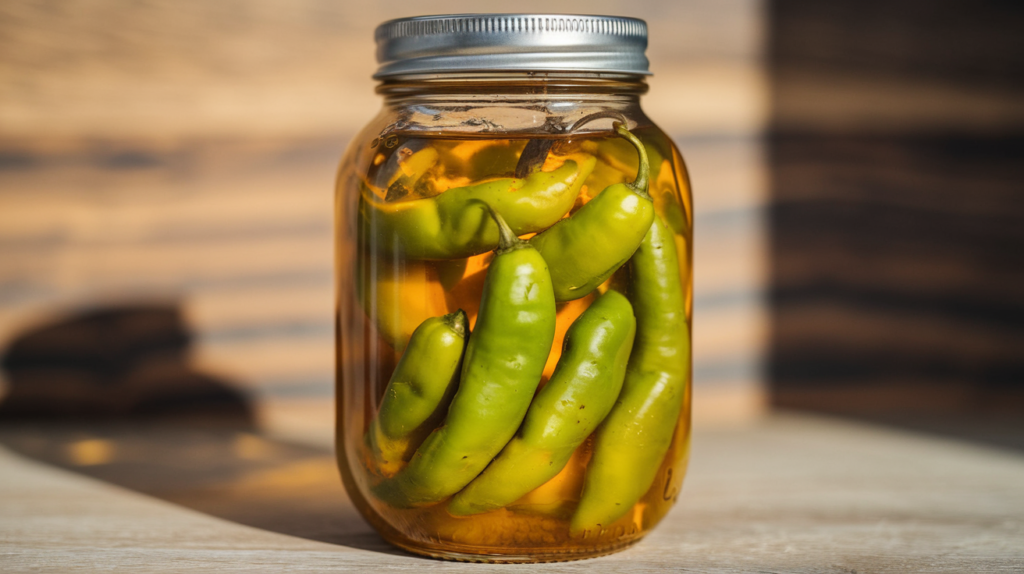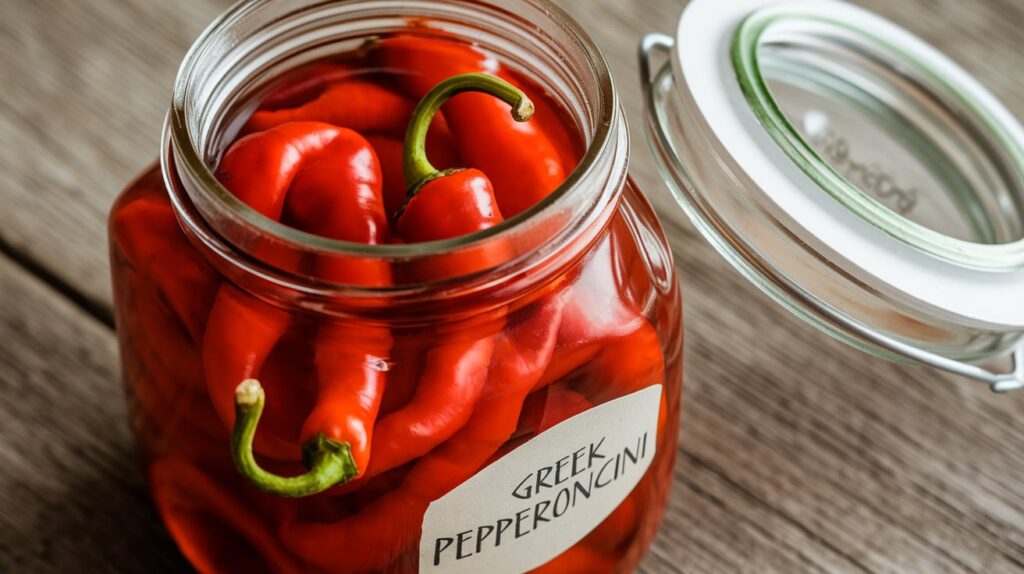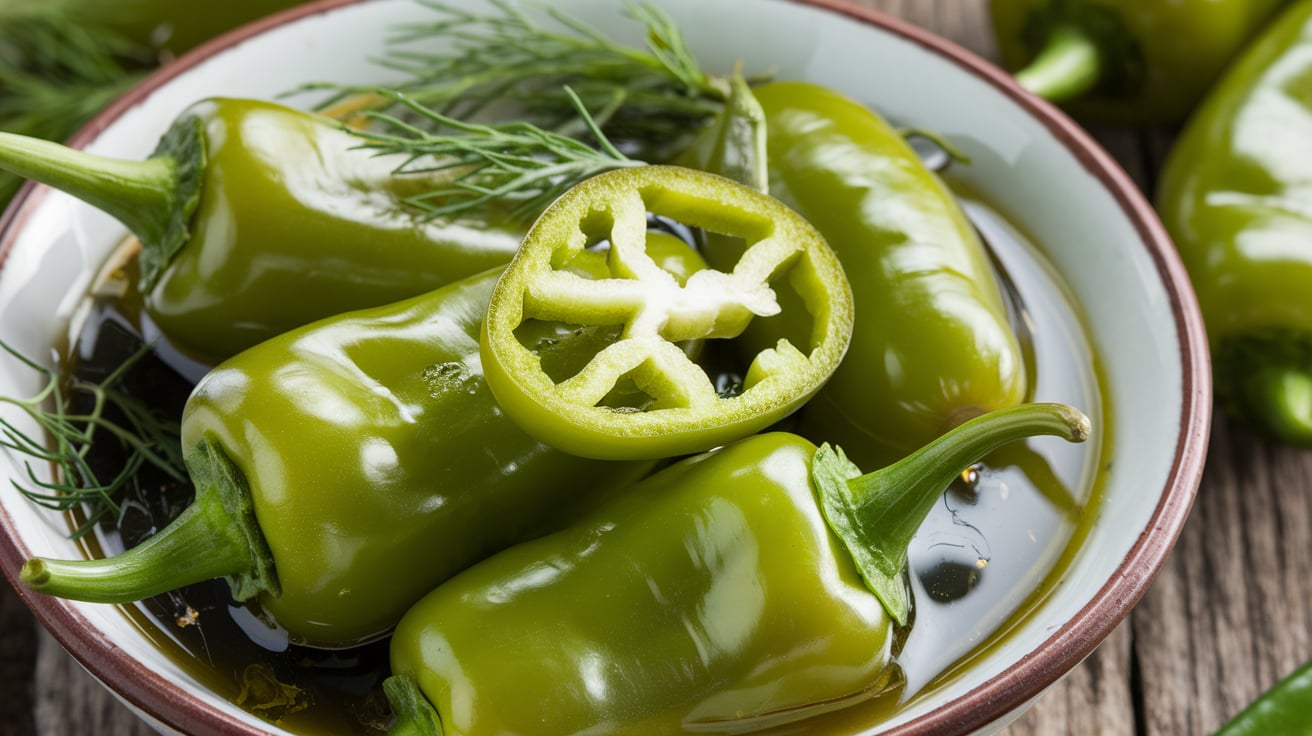Discover the Zesty Delight of Greek Pepperoncini
As you explore your local farmers’ market, the smell of Greek pepperoncini peppers catches your attention. These small, mild chili peppers are key in the Mediterranean diet. They mix sweet and spicy flavors that can make any dish better.
Looking to spice up your Greek gyro? Or maybe you want the crunchy taste of pickled pepperoncini on your sandwich? These Mediterranean peppers will surely excite your taste buds.
Table of Contents
Key Takeaways
- Greek pepperoncini peppers are a classic ingredient in Mediterranean cuisine, known for their mild heat and tangy flavor.
- These spicy Greek peppers are popular for pickling and can add a unique twist to a variety of dishes, from salads to pasta.
- Pepperoncini peppers are relatively low in calories and carbs, making them a healthy choice for those looking to add some heat and flavor to their meals.
- Growing your own Greek chili peppers can be a rewarding experience, as they are compact and well-suited for small gardens or containers.
- Pickled pepperoncini can be a delicious and versatile Greek condiment to have on hand, adding a zesty punch to sandwiches, burgers, and more.
What Are Greek Pepperoncini Peppers?
Greek pepperoncini peppers are also known as Mediterranean peppers, Italian peppers, and more. They come from the Mediterranean and are mild chili peppers. These peppers are thin-skinned, light green, and about 2 to 3 inches long. They have a zesty, slightly spicy taste that’s great for many dishes.
Origins and History of Pepperoncini Peppers
Pepperoncini peppers started in Central and South America. Spanish explorers brought them to Europe. They became very popular in Greece and Italy, where they’re a key ingredient in many dishes.
Varieties: Greek vs. Italian Pepperoncini
Greek and Italian pepperoncini are similar but have some differences. Greek ones are shorter, sweeter, and less bitter. Italian ones are longer and slightly more bitter. Both are mild, with a heat level of 100 to 500 Scoville units. This makes them great for many recipes.
| Characteristic | Greek Pepperoncini | Italian Pepperoncini |
|---|---|---|
| Length | 2-3 inches | 2-4 inches |
| Flavor | Sweeter, less bitter | Slightly more bitter |
| Heat Level | 100 – 500 Scoville | 100 – 500 Scoville |
The Unique Taste and Heat of Greek Pepperoncini
Peppers come in many flavors and heat levels. Greek pepperoncini are special because they mix mild heat with sweetness. They have a Scoville rating of 100-500 SHU, offering a gentle kick.
Scoville Heat Scale Rating
Pepperoncini are milder than many peppers. Bell peppers are sweet and have no heat, while jalapenos are much hotter. This makes pepperoncini great for those who want a little spice.
Comparison with Other Peppers
Pepperoncini are unique, but there are other mild peppers too. Banana peppers taste similar and have a similar heat level. Hungarian wax peppers are a bit hotter but still mild.
| Pepper Variety | Scoville Heat Units (SHU) | Heat Level |
|---|---|---|
| Bell Pepper | 0 SHU | Mild |
| Pepperoncini | 100-500 SHU | Mild |
| Banana Pepper | 0-500 SHU | Mild |
| Jalapeno Pepper | 2,500-8,000 SHU | Medium |
| Hungarian Wax Pepper | 5,000-15,000 SHU | Medium-Hot |

Nutritional Benefits of Pepperoncini Peppers
Pepperoncini peppers are small but full of nutrients. They are low in calories and carbs. They also have vitamins, minerals, and antioxidants that are good for your health.
Low in Calories and Carbs
Pepperoncini peppers are great for those watching their weight. A serving of four peppers has about 10 calories and 2 grams of carbs. They are a healthy choice for any meal.
Rich in Vitamins and Antioxidants
- Pepperoncini peppers are packed with vitamin C. They give you 75% of your daily needs in just one serving.
- They also have vitamin A. This vitamin is key for healthy skin, vision, and immune function.
- Pepperoncini are full of antioxidants. These help protect your cells and lower the risk of diseases like cancer and heart disease.
| Nutrient | Amount per Serving | Percentage of Daily Value |
|---|---|---|
| Calories | 10 | – |
| Carbohydrates | 2g | – |
| Fiber | 1g | 4% |
| Vitamin C | 4mg | 75% |
| Vitamin A | 250 IU | 5% |
| Calcium | 12mg | 3% |
| Iron | 0.4mg | 2% |
Adding pepperoncini nutrition to your diet boosts your immune system and skin health. These low-calorie peppers bring a healthy touch to your meals. They are a great way to enjoy healthy Mediterranean peppers.
Growing and Harvesting Your Own Pepperoncini Peppers
Growing your own pepperoncini peppers is a fun and tasty journey. These bright chili peppers love warm weather, making them perfect for gardeners with big or small spaces. With the right care, you can enjoy the fresh taste of homegrown pepperoncini from your garden.
Pepperoncini plants are easy to grow. They need well-drained soil and lots of sunlight. Plant them in a sunny spot to get at least 6 hours of direct sunlight daily. As they grow, watch the peppers change from green to red. This lets you harvest pepperoncini at different stages for different flavors.
- Pepperoncini plants are small and bushy, great for containers or small gardens.
- They naturally keep pests away, helping your other plants stay healthy.
- Make sure the soil pH is between 6.0 and 6.8 for the best growth.
Keep the soil moist but not too wet to avoid root rot. As the peppers get ripe, start picking them. You can pick them one by one or cut the whole plant for more.
“Growing pepperoncini peppers in my backyard garden has been a delightful experience. The vibrant colors and zesty flavors they add to my favorite dishes make the effort so worthwhile.”

With a little care, you can enjoy the fun of growing pepperoncini peppers. Whether you’re new to gardening or have been doing it for years, the joy of homegrown pepperoncini will make your taste buds happy.
Pickling and Preserving Pepperoncini Peppers
Pepperoncini peppers are great for pickling. Their mild heat and tangy taste make them perfect for vinegar or brine. Pickling lets you enjoy its zesty flavor all year.
Traditional Pickling Methods
Traditional pickling uses brine from water, vinegar, salt, and spices. The hot brine is poured over the peppers, and it takes weeks to get the peppers just right.
Quick Pickled Pepperoncini
For a quicker option, try quick pickling. This method involves soaking the peppers in vinegar and chilling them for days. It makes quick pickled pepperoncini ready in no time.
| Statistic | Value |
|---|---|
| Recipe rating | 4.43 out of 5 based on 90 votes |
| Pickling Time | 28 days |
| Serving Size | 1 pepper |
| Author | Colleen @ Grow Forage Cook Ferment |
| Total Time | 25 minutes (prep time: 10 minutes, cook time: 15 minutes) |
| Ingredients | 1 quart Mason Jar 1 cup water 1 cup cider vinegar 2 tsp sugar or honey 1 Tbsp kosher, pickling, or sea salt 1/4 tsp coriander seeds 1/4 tsp peppercorns 1 clove garlic 1 bay leaf |
| Peppers readiness | 2-4 weeks after preparation |
| Nutritional information | 5 calories per serving |
| Recommended utensils | Sharp Knife Quart Mason Jar Small Pot |
Whether you pick traditional or quick pickling, making pickled pepperoncini at home is rewarding. Enjoy the tangy, zesty taste of homemade pickled pepperoncini all year!
Conclusion
Growing Greek pepperoncini peppers in your garden is rewarding. They are easy to grow and offer many benefits. These peppers are great for adding flavor to your meals.
Pepperoncini peppers have a zesty taste with a Scoville rating of 100 to 500 units. They are perfect for adding a bold flavor to dishes. This makes them great for Mediterranean cooking.
Try growing pepperoncini peppers in your garden or pantry. They are perfect for salads, sandwiches, and pickling. They add depth and complexity to any dish.
FAQ
What are Greek pepperoncini peppers?
Greek pepperoncini peppers are a type of mild chili pepper. They come from Italy and Greece. They have a thin skin, light green color, and are 2-3 inches long.
What is the difference between Greek and Italian pepperoncini peppers?
Greek pepperoncini are shorter and sweeter than Italian ones. Italian ones are a bit longer but just as mild.
How hot are pepperoncini peppers?
Pepperoncini peppers are very mild, with a heat level of 100-500 Scoville Heat Units. They are much milder than jalapeno peppers.
What are the nutritional benefits of pepperoncini peppers?
They are low in calories and carbs but high in vitamins A and C. They also have antioxidants, fiber, iron, and calcium. This makes them a healthy choice.
How do you grow and harvest pepperoncini peppers?
Growing pepperoncini peppers is easy. They need warm weather, good soil, sunlight, and water. They grow well in small gardens or containers. As they ripen, they turn from green to red, ready to be picked.
How can you preserve and pickle pepperoncini peppers?
Pickling is a great way to keep pepperoncini peppers tasty all year. You can use a traditional brine or a quick vinegar soak. Then, just refrigerate them.
This makes them a healthy choice.
classic ingredient in Mediterranean cuisine







